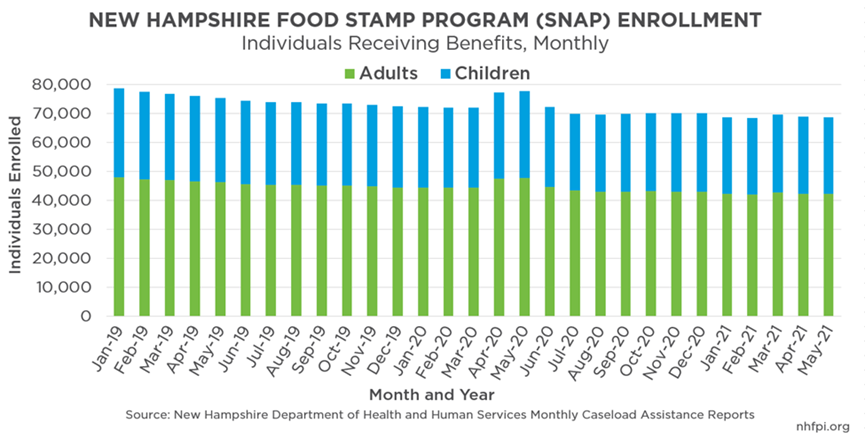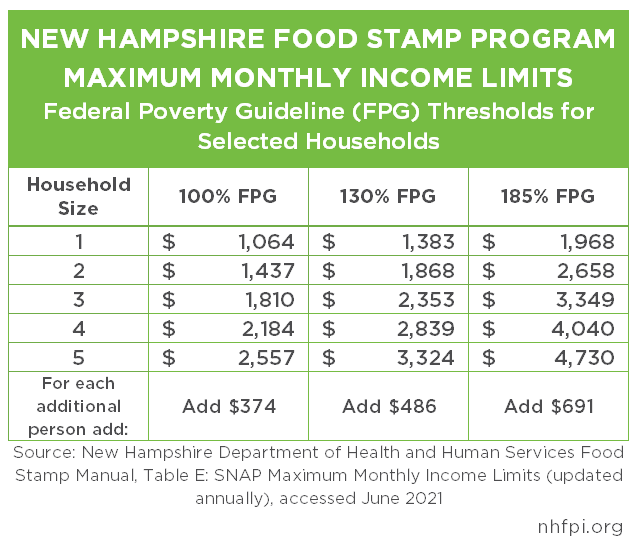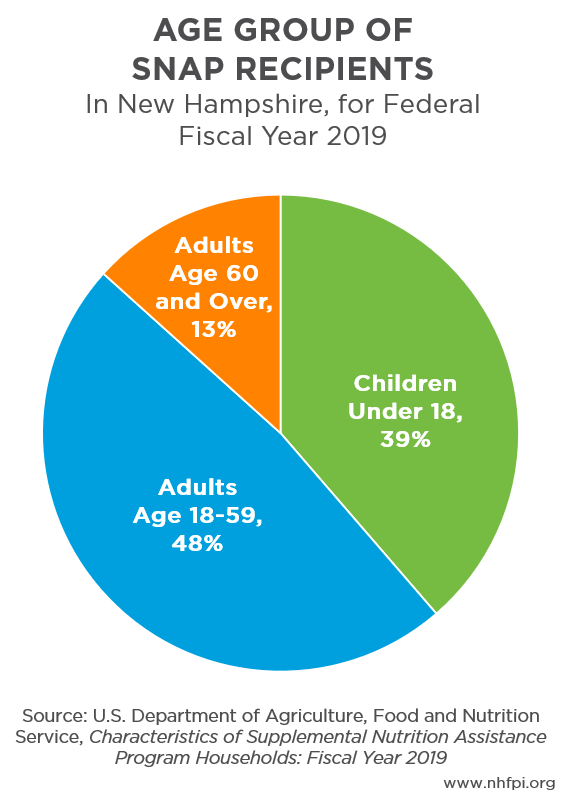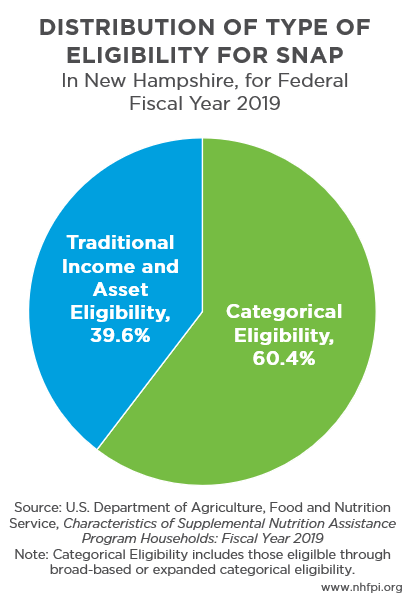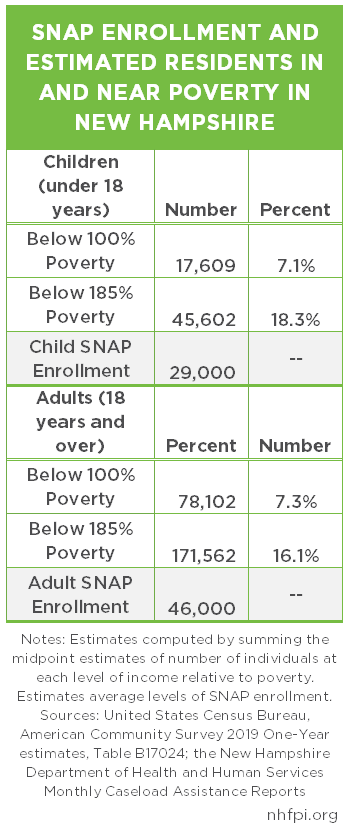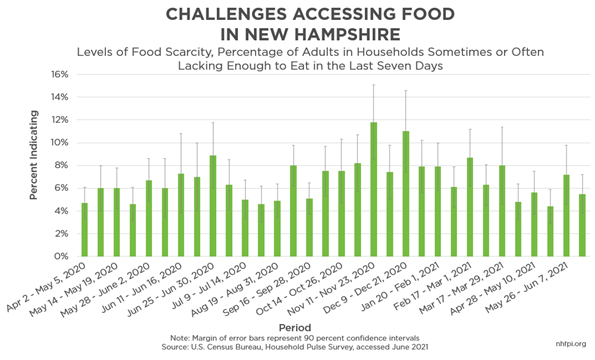The Supplemental Nutrition Assistance Program (SNAP) provides essential nutritional aid to individuals and families throughout the nation. This program is administered in the Granite State as the New Hampshire Food Stamp Program, and provided nutrition assistance to about 29,000 children and more than 45,000 adults each month throughout 2019. These benefits are federally funded and dispersed to eligible New Hampshire residents who may be experiencing food insecurity.
Eligibility for SNAP is means-tested and based on income, assets, expenses and household composition, or participation in certain other means-tested aid programs. SNAP is designed to target assistance to individuals and families with low incomes and limited resources. This targeted aid has several beneficial effects beyond directly providing nutritional aid and mitigating levels of food insecurity. This aid boosts the economy, as each new dollar of SNAP benefits generates more than a dollar of economic output and supports grocers throughout the state.
While SNAP provides food assistance to people with limited resources and supports the economy, there are more eligible individuals in New Hampshire than are enrolled. Estimates show there were up to 17,000 additional children eligible for aid who were not receiving it in 2019, as well as tens of thousands of adults who were likely eligible but not enrolled. If 17,000 more children in the state had been enrolled in SNAP in 2019, and each child was in a separate household that received the average benefit amount during that year, then an additional $37.9 million in federally-funded aid would have flowed to New Hampshire to support Granite State families and the economy during that year. The ongoing COVID-19 crisis has created additional challenges to accessing and affording food, and may have expanded the gap between the size of the population eligible for nutritional aid through SNAP and the number of individuals receiving assistance.
This Issue Brief examines key aspects of SNAP, including an overview of the program’s eligibility requirements, benefits, and impacts. Analysis in this Issue Brief discusses food insecurity and quantifies the potential levels of under enrollment in SNAP. This Issue Brief also explores the challenges in affording or accessing food and the impacts of the COVID-19 crisis on SNAP enrollment.
Program Overview, Enrollment and Economic Impacts
SNAP provided nutritional aid to approximately 75,000 Granite Staters each month on average during 2019. Of those individuals, an average of about 29,000, or nearly 40 percent, were children.[1] SNAP benefits are fully funded by the federal government, and administrative costs of the program are split between the federal and state governments.[2] By design, SNAP is targeted to provide aid to households with low incomes and few resources who may be most likely to experience difficulties in accessing food. Difficulty in accessing and affording food is formally described as food insecurity, and is defined as when “households [are], at times, unable to acquire adequate food for one or more household members because they had insufficient money and other resources for food,” according to the United States Department of Agriculture.[3] National data show that food insecurity is more prevalent in households: that have children, that are headed by single parents, that have incomes below 185 percent of the poverty thresholds, or where the householder identifies as African-American or Hispanic.[4]
In New Hampshire, the most recent estimates from before the COVID-19 pandemic indicated that 6.6 percent of households were food insecure, equating to about 35,000 households in the state.[5] Stable access to food is vital for the development and health of children as well as the health of adults. Food insecurity has negative effects on children and adults, both physiologically and psychologically. Adults experiencing food insecurity are likely to have lower levels of overall health.[6] Many New Hampshire communities and groups face barriers or challenges to strengthening their economic well-being and security. SNAP aid is targeted towards these individuals experiencing economic hardships or poverty.[7] In New Hampshire, households receiving SNAP benefits had an estimated median income of about $22,000 per year, compared to an estimated median of nearly $72,000 per year for households not receiving SNAP benefits.[8]
Overview of the New Hampshire Food Stamp Program
Eligibility for SNAP is determined for households based on several factors, including levels of gross income, net income (gross income minus allowable expenses, including child care, housing rental, and utility costs within certain parameters), assets (excluding certain assets, including a primary residence and vehicle), and the composition and number of individuals in a household. In certain cases, only some members of a household may be eligible for benefits. Additionally, some non-citizens and legal permanent residents are eligible to receive benefits.[9] Most households will qualify for assistance if gross income is less than or equal to 130 percent of the Federal Poverty Guidelines (or 165 percent for individuals who have a disability or are age 60 and over), net income is less than or equal to 100 percent of the Federal Poverty Guidelines, and assets total no more than $2,250, or $3,500 (with certain exemptions) for households with members who are older adults or have a disability.[10]
In addition to these eligibility guidelines, certain households may be eligible for SNAP benefits through categorical eligibility and expanded categorical eligibility. Expanded categorical eligibility allows for states to provide federally-funded SNAP benefits beyond the federal 130 percent gross income standard while permitting households that are otherwise eligible to access benefits without an asset test. Through regular and expanded categorical eligibility, households are eligible if all members receive public assistance through other assistance programs or including Supplemental Security Income.[11] Households may also qualify if they meet the state’s expanded categorical eligibility criteria, meaning they earn gross income less than or equal to 185 percent of the Federal Poverty Guidelines and have a dependent child with a relative in the household.[12] Of the 44 states that utilize expanded categorical eligibility to extend eligibility for SNAP aid, New Hampshire is the only state that limits this expanded eligibility to households with at least one child. Nineteen other states and territories also allow for gross income eligibility up to 200 percent of the Federal Poverty Guidelines.[13] In addition to income and resource requirements, certain households and individuals must also comply with work requirements.[14]
SNAP benefits are distributed to households through Electronic Benefit Transfer cards. The resources accessible through these cards may only be used for food items for human consumption, and exclude items such as prepared hot foods, vitamins, paper products, soap, alcohol, and tobacco.[15] Benefits are determined based on household income, size, and the deduction of certain expenses; benefit amounts decrease on a sliding scale as the household’s income rises closer to the net income eligibility limits.[16] Prior to the COVID-19 crisis, the maximum benefit for a household was $374 for a household of two and $680 for a household of four.[17] In 2019, a household of three people in New Hampshire with no remaining net income after eligible expenses were deducted would receive a maximum benefit of $509, or $1.88 per person per meal.[18] Minimum benefits are as low as $16 dollars a month for certain households.[19] In New Hampshire, the average monthly benefit before the COVID-19 crisis was $186 dollars, and the average household size receiving benefits was 1.9 individuals.[20]
Program Enrollment
Prior to the onset of the COVID-19 crisis, total enrollment in SNAP in New Hampshire was slowly declining due to improving economic conditions. Enrollment data from 2019 show that an average of approximately 45,000 adults and 29,000 children were receiving assistance.[21] The latest federal data from fiscal year 2019, which encompasses October 2018 through September 2019, provides additional breakdowns on the enrollment and reach of SNAP assistance in New Hampshire. Over one-third of all recipients in the state were children, about half were adults age 18 to 59, and the remainder were adults age 60 and over. About one-quarter of households receiving benefits were single adults with children, and about 40 percent included adults under age 60 with disabilities.[22]
These data also show how households were determined to be eligible for assistance. Approximately 13,000 (39.6 percent) of the 39,000 recipient households were eligible through traditional income and asset eligibility. These households may include those with incomes lower than the Federal Poverty Guidelines. The remaining majority, about 24,000 households (60.4 percent), were eligible for SNAP assistance through a form of categorical eligibility. These remaining households include members who were receiving another form of assistance through Supplemental Security Income, Temporary Assistance to Needy Families, Old Age Assistance, Aid to the Permanently and Totally Disabled, or Aid to the Needy Blind. This also includes households eligible under expanded categorical eligibility, which include households that have a dependent child, receive other non-cash aid, and have incomes of under 185 percent of the Federal Poverty Guidelines.[23]
Economic Boosts Provided by Nutritional Aid
SNAP benefits provide economic boosts during times of economic recession, recovery, and expansion, in addition to directly assisting individuals and families struggling with food insecurity.[24] The Great Recession, which occurred from 2007-2009, resulted in increased levels of food insecurity in New Hampshire and increased enrollment in SNAP as more households were facing economic challenges and reduced incomes.[25] Analysis of federal economic stimulus policies during the Great Recession by Moody’s Analytics showed that every dollar invested into new SNAP benefits to support individuals and families generated $1.74 of economic activity.[26] More recent analysis from the United States Department of Agriculture in 2019 estimated that every dollar invested in new SNAP benefits would generate about $1.50 in economic activity when the economy is weak.[27] Throughout 2019, an estimated $87.18 million dollars were dispersed to SNAP recipients in New Hampshire, aiding households, and stimulating local economies.[28]
Under Enrollment and the Reach of Nutritional Aid
Both the challenge of food insecurity and eligibility for nutritional aid through SNAP are dependent primarily on levels of income relative to poverty. Significant numbers of Granite Staters were living in or near poverty in 2019, and there are notable differences between the number of Granite Staters enrolled in SNAP and the number of Granite Staters facing economic challenges that may be significant enough to result in eligibility for SNAP.
Potential Levels of Under Enrollment
Throughout 2019, monthly average enrollment in SNAP totaled about 39,000 households. These households were comprised of about 75,000 individuals, of which approximately 45,000 were adults and 29,000 were children.[29] During the same year, one-year estimates from the United States Census Bureau’s American Community Survey show that about 171,000 adults and about 46,000 children had incomes under 185 percent of poverty. The differences between these estimated numbers of individuals at 185 percent of poverty and actual 2019 enrollment indicates that there are likely many Granite Staters who may be eligible for SNAP but are not receiving benefits.[30]
Not all individuals in New Hampshire with incomes under 185 percent of poverty are categorically eligible for SNAP, as State program rules require there be a dependent child household member and that the household receives certain other public assistance.[31] However, children in households at 185 percent of poverty or below should be eligible for SNAP in nearly all cases. This suggests that there may have been approximately 17,000 children in New Hampshire who were eligible for SNAP assistance but were not enrolled in the program. This may indicate that, based on these gross income estimates but with benefits still dependent on net income calculations, about one third of children in the state who are eligible for SNAP are not enrolled. Utilizing eligibility data for free and reduced-price school meal programs in New Hampshire also indicate significant levels of under enrollment, as this program has similar income eligibility requirements. In October 2019, 38,624 students enrolled in grades 1 through 12 at public school were eligible for free or reduced-price meals.[32] This is greater than the 29,000 children enrolled in SNAP monthly in 2019, despite excluding young children who are not yet in first grade and other children not enrolled in public schools in New Hampshire.
Estimates of poverty for adults lead to similar findings in terms of potential under enrollment of eligible adults. If New Hampshire were to eliminate the requirement for a dependent child to be present in a household for expanded categorical eligibility, up to 125,000 Granite State adults may be eligible for assistance based on their low incomes alone. Data published by the Census Bureau do not provide an estimate for adults below 130 percent of poverty, but estimates of individuals 18 years old and older with incomes up to 125 percent of poverty show about 104,000 adults below this income level. Because adults under age 60 and without children can only be eligible for SNAP with gross incomes below 130 percent of poverty, potential under enrollment of this group may be significant as well. American Community Survey data show that nearly 80,000 adult New Hampshire residents have incomes below 100 percent of poverty; these Granite Staters are more likely to be eligible for both SNAP and other aid programs.
Forgone Federal Aid and Economic Stimulus
The average household SNAP benefit in 2019 in New Hampshire was $186 per month in assistance.[33] If an estimated 17,000 children in the state, who may have been eligible for benefits but were not enrolled in SNAP, became enrolled in 2019, and each were in a separate household that received the average benefit during that year, then an additional $37.9 million in federally-funded aid would have been received and spent in the local economy during that year. This additional aid would have increased the total amount of federal SNAP dollars flowing to New Hampshire to ease food insecurity and help local businesses by approximately 44 percent.
Using the same methodology, if the state were to remove the requirement for a dependent child to be present in a household for expanded categorically eligibility, then up to 125,000 Granite State adults who may be eligible for assistance based on their low incomes would be eligible for significant amounts of fully federally-funded aid. If these 125,000 Granite Staters were enrolled and received the minimum benefit, an additional approximately $24 million in federal nutritional aid would have been dispersed into New Hampshire in 2019.[34]
Under enrollment in SNAP may have resulted in forgone economic stimulus and growth in New Hampshire due to SNAP’s multiplier effect and decreased the overall level of dollars spent on food that support local grocers and economies. Analysis from the United States Department of Agriculture in 2019 estimated that every dollar invested in new SNAP benefits would generate about $1.50 in economic activity when the economy is weak.[35] The potential of this forgone federal aid also impacts economic stimulus during weak economic conditions or recession, by limiting the amount of economic stimulus and support for individuals and families with lower incomes.
Food Assistance and Nutritional Aid During the COVID-19 Crisis
The ongoing COVID-19 crisis has led to profound and uneven impacts for Granite Staters. Historic increases in levels of unemployment and job losses, which were most acute for individuals working in industries paying lower than average wages, compounded many challenges for vulnerable groups of Granite Staters. State and federal responses to the pandemic provided significant aid in the form of expanded unemployment and other support. Notably, for much of the pandemic, SNAP benefits have been increased to the maximum allotments for all households to provide additional support, and certain recertification criteria have been temporarily waived. Despite this and other supports that were put in place, there were additional economic challenges for certain individuals and families.[36]
Data collected by the United States Census Bureau’s Household Pulse Survey indicate many households continue to face hardship. The survey showed that about half of New Hampshire adults reported a loss of household employment income between March and July 2020. Additionally, at the end of 2020, about one in four households expected future employment income losses, and about one in three reported difficulty paying for usual expenses in New Hampshire. From August 2020 to June 2021, between one in three and one in six households surveyed in New Hampshire indicated it had been somewhat or very difficult to afford usual household expenses in the last seven days.[37]
Other data collected by the Household Pulse Survey may suggest that there is continued under enrollment in SNAP. Throughout 2020, there were increases in estimated levels of food scarcity, defined by the Census Bureau as when the household’s members sometimes or often did not have enough to eat in the last seven days.[38] After an initial increase in April and May of 2020, enrollment in SNAP declined month-over-month despite these increased challenges in accessing food. These indicators suggest that households that may have been eligible for SNAP did not enroll in the program.[39]
Concluding Discussion
The Supplemental Nutrition Assistance Program provides targeted and impactful aid to individuals and families with limited resources so they can afford food. The program’s design allows it to be responsive to times of economic decline, as eligibility is based on income, assets, expenses, household composition, or participation in certain other assistance programs. However, many households in New Hampshire may not be enrolled despite meeting these eligibility requirements. This analysis of potential SNAP under enrollment shows that up to 17,000 additional children and many more adults may have been eligible for SNAP in 2019, but were not enrolled in the program. This estimated under enrollment of households with children may have resulted in approximately $37.9 million of foregone federal aid in 2019 alone. This estimated under enrollment may have resulted in the loss of accompanying economic stimulus to local economies and grocers as well. Levels of under enrollment in nutritional aid in SNAP may have continued throughout the duration of the ongoing COVID-19 crisis, as data collected by the U.S. Census Bureau show that significant portions of New Hampshire’s population faced declining or lost incomes and challenges affording expenses and food, even while enrollment in SNAP declined overall. Additional policies or programs may be required to help ensure that assistance reaches eligible Granite State individuals and families, and supports an equitable, inclusive recovery for everyone in New Hampshire.
Revision, September 14, 2021:
The graph titled “Age Group of SNAP Recipients” and an accompanying sentence on page four have been updated to correct an error in the relative magnitudes of each age group.
Endnotes
[1] Averages for calendar year 2019 are calculated utilizing the New Hampshire Department of Health and Human Services Monthly Caseload Assistance Reports.
[2] For additional resources, see the New Hampshire Food Stamp Manual, the New Hampshire Division of Health and Human Services, and the Center on Budget and Policy Priorities report Policy Basics: The Supplemental Nutrition Aid Program (SNAP).
[3] The Economic Research Service of the United States Department of Agriculture defines food insecurity and the methodology for measuring food insecurity in the Department’s yearly data and estimate releases.
[4] Characteristics of groups who experience food insecurity, and trends over the 2017-2019 period, were calculated and released by the Economic Research Service of the United Sates Department of Agriculture.
[5] Estimates of household food insecurity yearly at the national level, and over three-year periods at the national, state, and substate levels, are collected, calculated, and analyzed by the Economic Research Service of the United States Department of Agriculture. Yearly releases and publications of these data and analyses are collected on this resource page.
[6] Health outcomes of individuals experiencing food insecurity are discussed in the Economic Research Service of the United States Department of Agriculture October 2017 publication Adults in Households With More Severe Food Insecurity Are More Likely To Have a Chronic Disease.
[7] See Feeding America’s resource page on the effects of food insecurity.
[8] Estimates provided by the United States Census Bureau’s American Community Survey 2019 one-year estimates. See table B22008.
[9] New Hampshire Food Stamp Manual Section 305.
[10] New Hampshire Food Stamp Manual Section 611 and 403. Additionally, households including members that are age 60 or over or a member with a disability are not subject to the gross income test, but are subject to a net income test of 100 percent of FPG. These households must also pass a resource test to be considered financially eligible for SNAP benefits.
[11] Other public assistance programs include Temporary Assistance to Needy Families, Old Age Assistance, Aid to the Permanently and Totally Disabled, or Aid to the Needy Blind.
[12] New Hampshire Food Stamp Manual Section 231.
[13] For information on expanded categorical eligibility guidelines in New Hampshire and other states, see the United States Department of Agriculture, Food and Nutrition Service Info Sheet on Broad-Based Categorical Eligibility, updated July 2021.
[14] In most cases, SNAP guidelines requires that all individuals aged 16 to 59 years receiving SNAP benefits who are able to engage in employment must work at least 30 hours per week, register for work, participate in the state’s employment program, or take a suitable job if offered one. Exemptions are made for those who are receiving unemployment benefits, have a dependent under the age of 6 in their household; care for a person with disabilities in their household; are physically or mentally unfit to work; participate in drug or alcohol treatment programs; or are in school or a training program at least half-time. However, adults age 18 to 49 who do not have dependents typically are not able to receive benefits for more than three months out of a thirty-six month period unless they work or volunteer 80 hours a month, participate in work programs such as SNAP Employment and Training for at least 80 hours a month, or participate in a combination of work or volunteering and work training equaling at least 80 hours per month. Exemptions to these requirements are made during times of high unemployment, or based on other individual-level factors. Individuals in this age group are exempt from these additional requirements if they are: physically or mentally limited and cannot work, pregnant, or have an individual under age 18 in their household. Able-bodied adults age 18 to 49 without dependents who do not meet these requirements or exceptions will lose their benefits after three months. See the New Hampshire Food Stamp Manual Section 245.
[15] Detailing of items that can and cannot be purchased utilizing SNAP benefits is available from the United States Department of Agriculture Food and Nutritional Service.
[16] New Hampshire Food Stamp Manual Section 611.
[17] New Hampshire Food Stamp Manual Table F.
[18] New Hampshire Food Stamp Manual Table F.
[19] See the Center on Budget and Policy Priorities report A Quick Guide to SNAP Eligibility and Benefits.
[20] This figure is for federal fiscal year 2019. For additional information, see the United States Department of Agriculture, Food and Nutritional Service report titled Characteristics of SNAP Households: FY 2019.
[21] Averages for calendar year 2019 are calculated utilizing the New Hampshire Department of Health and Human Services Monthly Caseload Assistance Reports.
[22] See the United States Department of Agriculture, Food and Nutritional Service report Characteristics of SNAP Households: FY 2019.
[23] See the United States Department of Agriculture, Food and Nutritional Service report Characteristics of SNAP Households: FY 2019.
[24] For an overview of SNAP and the New Hampshire Food Stamp Program, see NHFPI’s October 2019 updated Fact Sheet The New Hampshire Food Stamp Program.
[25] See NHFPI’s December 2020 Issue Brief Food Insecurity and Economic Conditions in New Hampshire and the Nation.
[26] Information on the multiplier effect of SNAP benefits during the Great Recession is available from the Moody’s Analytics July 2010 publication How the Great Recession Was Brought to an End.
[27] See the United States Department of Agriculture, Food and Nutritional Service report The Supplemental Nutrition Assistance Program (SNAP) and the Economy: New Estimates of the SNAP Multiplier.
[28] See the United States Department of Agriculture, Food and Nutritional Service report Characteristics of SNAP Households: FY 2019. For information of SNAP’s impacts on local economies and grocers, see this blog from the National Grocers Association.
[29] Averages for calendar year 2019 are calculated utilizing the New Hampshire Department of Health and Human Services Monthly Caseload Assistance Reports.
[30] Estimates computed by summing the midpoint estimates of the number of individuals at each level of income relative to poverty. See the United States Census Bureau’s American Community Survey 2019 one-year estimates, table B17024.
[31] Other public assistance programs include Supplemental Security Income, Temporary Assistance to Needy Families, Old Age Assistance, Aid to the Permanently and Totally Disabled, or Aid to the Needy Blind. See New Hampshire Food Stamp Manual Section 231.
[32] Information on free and reduced-price meal eligibility is available from the New Hampshire Department of Education.
[33] This figure is for federal fiscal year 2019. For additional information, see the United States Department of Agriculture, Food and Nutritional Service report Characteristics of SNAP Households: FY 2019.
[34] It would be unlikely that all estimated 125,000 New Hampshire adults not enrolled in SNAP in 2019 would be eligible to receive the average or maximum benefit, as benefits are calculated on a sliding scale based on net income. During the ongoing COVID-19 pandemic, all recipients are receiving maximum benefits, but that has not been and may not continue to be the case during typical economic conditions. If these potential under enrolled individuals received the maximum benefit in 2019, an additional $294 million in benefits would have been provided during 2019.
[35] See the United States Department of Agriculture, Food and Nutritional Service report The Supplemental Nutrition Assistance Program (SNAP) and the Economy: New Estimates of the SNAP Multiplier.
[36] See NHFPI’s May 2020 blog Unemployment Insurance and the Continued Economic Recovery from the COVID-19 Crisis.
[37] See the United States Census Bureau’s Household Pulse Survey data tables.
[38] See the United States Census Bureau’s Household Pulse Survey data tables.
[39] SNAP enrollment in 2020 provided by the New Hampshire Department of Health and Human Services Monthly Caseload Assistance Reports.

